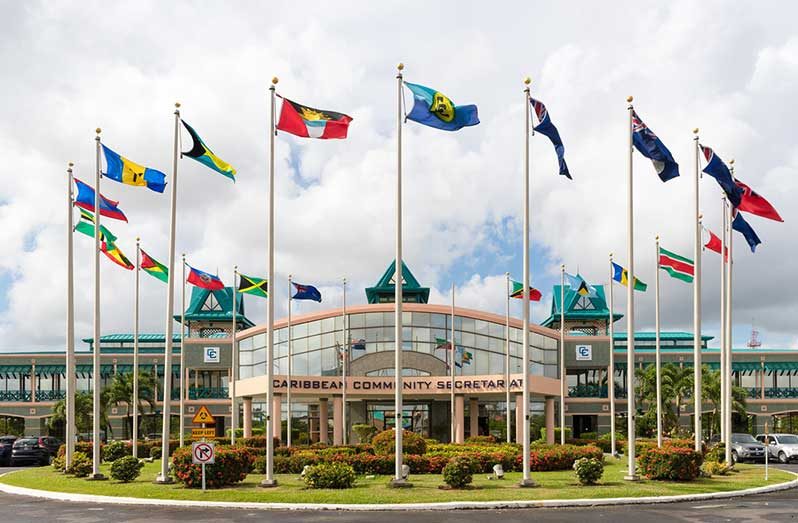– potential sales ‘a bit premature,’ Natural Resources Minister says
GUYANA is making significant progress in its journey to become a prominent oil and gas production hub within the Caribbean Community (CARICOM). Furthermore, several neighboring nations have already expressed their intention to procure gas from Guyana.
This was recently revealed by Guyana’s Natural Resources, Minister Vickram Bharrat who during a recent news conference told reporters that while the government here has received interest, it’s still a premature discussion, as Guyana first must ensure that its local demands are being met.
“A number of CARICOM countries, yes, have already approached us to purchase gas from Guyana, but I think it is a bit premature now to say who we can sell to and how much we can sell them,” the Minister said.
Currently works are underway to construct the country’s first gas-to-energy project.
“Already we are looking at a second power plant because the rate we are developing as a country, the demand for energy is increasing significantly.”
The goal of the Gas-to-Energy project is to build the necessary infrastructure for the transportation of natural gas from the Liza oilfield, located offshore in the Stabroek Block, to an integrated gas processing facility located in Wales, on the West Bank of Demerara. The project will provide dry gas and natural gas liquids (NGL) to the Guyana government.
While this is underway, the government has already floated talks that a second power plant will be required in light of the burgeoning development occurring countrywide.
“The demand for energy is increasing significantly…we have new hotels coming on stream, you have thirty something thousand house lots awarded by the government, we have many companies building their headquarters here, we have six brand new hospitals coming on stream, we will definitely need more power in the system,” he noted.
The gas to energy project has several components, the first being the pipeline; the second building of the Power Plant and the Natural Gas Liquids (NGL) facility; thirdly, the transmission main to move the power to the control centre; fourthly, the control centre, and fifthly the upgrade of the transmission and distribution system.
Last week it was reported that soil remediation is currently in progress for the 300MW combined cycle power plant, a critical component of the initiative.
The remediation process typically includes removing pollutants or contaminants from the soil, which could otherwise pose risks to the environment, or compromise the structural integrity of the plant.
The Gas-to-Energy project, spearheaded by the Government of Guyana in collaboration with ExxonMobil and its Stabroek Block co-venture partners, CNOOC and Hess, is set to revolutionise the nation’s energy landscape.
The pipeline, designed to channel natural gas from ExxonMobil’s Liza Phase One and Liza Phase Two Floating, Production, Storage, and Offloading (FPSO) vessels, will be landed on the West Coast Demerara (WCD) shore before continuing approximately 25 km to the NGL and power-plant facilities in Wales, West Bank Demerara (WBD).
This infrastructure is expected to play a pivotal role in lowering energy costs by at least 50 per cent through an energy mix that includes gas, solar, wind, and hydropower.
The estimated total cost of the gas-to-energy project stands at US$1.8 billion, with the power plant and NGL facilities being funded by the government.
Notably, the conversion of natural gas from offshore operations to electricity is a cornerstone of the People’s Progressive Party/Civic (PPP/C) government’s commitment to energy sustainability, and reduced costs for consumers.
Back in February, the Caribbean Development Bank (CDB) reported that Guyana’s increased production of its oil and gas resources has been “a significant driver” of regional growth.
The CDB estimated that the region grew by 6.7 per cent with higher oil production in Guyana being a large contributor to the average regional growth in 2023.
According to the CDB, the country’s production increased by 35.2 per cent, and this influenced growth in non-oil sectors, contributing to the overall expansion of the country’s economy by roughly 32.9 per cent.
The CDB’s Director of Projects, Therese Turner-Jones, in an invited comment to this publication, had said the institution shares an excellent relationship with the Government of Guyana, and will be open to developing projects in renewable energy.
“We are keen on investing in energy projects once we are invited…,” Turner-Jones said.
The CDB, she said, has placed much emphasis on renewable energy projects in Borrowing Member Countries (BMCs).
In fact, Turner-Jones said that any project which could provide cheaper electricity is welcomed.
Guyana, she underscored, has the potential to provide the region with energy resources, however, the CDB is pursuing sustainable projects which limit the use of fossil fuels.
“[The]CDB is committed to advancing the region’s transition to sustainable energy in the face of climate change…our focus rests on energy security lowering electricity cost, reducing greenhouse gas emissions and climate proofing our grids,” Turner-Jones said.



.jpg)








